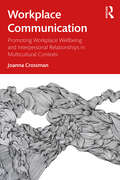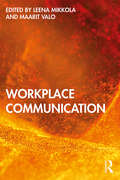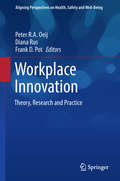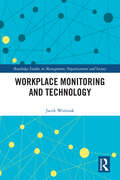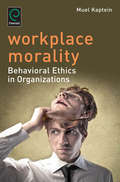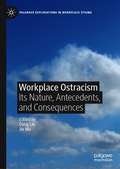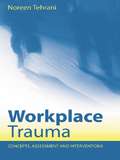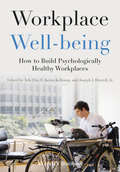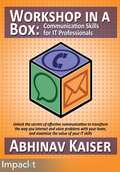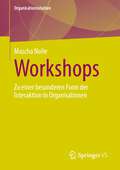- Table View
- List View
Workplace Communication: Promoting Workplace Wellbeing and Interpersonal Relationships in Multicultural Contexts
by Joanna CrossmanWorkplace Communication highlights how we can build interpersonal relationships through effective communication and why this is essential to workplace wellbeing. Well-supported by contemporary, reputable empirical studies, the book also comes with exercises and open-ended questions based on the subject matter. The book provides a comprehensive overview on creating an inclusive workplace and managing workplace diversity; covers a wide range of salient, up-to-date reputable literature on a wide range of management and business topics; contains practical, ‘road-tested’ activities to promote student reflection, experiential learning, critical thinking, research skills, and application of theory to practice and vice versa; examines how we communicate effectively to an increasingly diverse workforce. Designed for a broad audience, this book will appeal to academics and students in the fields of business management and communications. It will also be a useful reference for organisational practitioners and leaders.
Workplace Communication
by Leena Mikkola Maarit ValoThis book provides insights into communication practices that enable efficient work, successful collaboration, and a functional work environment. Maintaining a productive and healthy workplace is predicated on interpersonal communication between people. In organizations, efficient communication is the foundation of all actions. Contributors to this book cover communication issues in relationships, teams, meetings, leadership, competence, diversity, organizational entry, social support, and digital environments in the workplace. The book illustrates all these issues in detail by presenting both relevant research findings and their practical implications in working life. Workplace Communication is ideal for current and future employees, directors, supervisors and managers, instructors, and consultants in knowledge-based expertise work. The book is appropriate for courses in organizational and leadership communication or interpersonal communication in a workplace setting.
Workplace Communication
by Leena Mikkola Maarit ValoThis book provides insights into communication practices that enable efficient work, successful collaboration, and a functional work environment. Maintaining a productive and healthy workplace is predicated on interpersonal communication between people. In organizations, efficient communication is the foundation of all actions. Contributors to this book cover communication issues in relationships, teams, meetings, leadership, competence, diversity, organizational entry, social support, and digital environments in the workplace. The book illustrates all these issues in detail by presenting both relevant research findings and their practical implications in working life. Workplace Communication is ideal for current and future employees, directors, supervisors and managers, instructors, and consultants in knowledge-based expertise work. The book is appropriate for courses in organizational and leadership communication or interpersonal communication in a workplace setting.
Workplace Conflict: Mobilization and Solidarity in Argentina
by M. AtzeniBased on qualitative work in car plants in Argentina, this book offers new insights for an understanding of workers' collective struggles in a radical perspective. Criticizing the use of injustice as the basis of mobilization, it argues that workers' collective resistance should be seen as a function of the development of solidarity.
Workplace Culture Matters: Developing Leaders Who Respect People and Deliver Robust Results
by Robert B. CampWritten in a novel format, this book addresses the challenge of changing a "sick" culture. Some organizations wake up one day and realize they have become something they never intended. Their employees run scared. There is no innovation, only blind obedience. There are warlords within the ranks of management, and they fight over turf without considering the best interests of customers, their employees, or their organization as a whole. At the Charleston, SC, branch of Copper-Bottom Insurance, the wakeup call comes when an employee files a lawsuit against the company and its leaders. The Charleston division Vice President, Jack Simmons, is put on probation and given an ultimatum: "Change the culture!" Jack understands the "or be fired" implication all too well. He scrambles to find help and runs into an old friend, Don Spears, from Friedman Electronics. With Don’s help, Jack begins the journey that will heal his organization. In the course of their first visit, Don and his Director of Continuous Improvement, Tim Stark, help Jack to make an important discovery: Copper-Bottom’s executives are not showing their people respect. Don and Tim point to the following observations as proof. Copper-Bottom leaders are Using top-down, "command-and-control" leadership behaviors rather than recognizing their people as Subject Matter Experts and listening to them Issuing instructions to their people rather than observing then improving performance through coaching Keeping employees in the dark as to the impact their work has on the organization’s mission Unaware of the obstacles in their people’s paths; hence, never using the authority of their positions to remove those obstacles Staying in their offices, aloof to the difficulties their subordinates face As Don and Tim see it, Copper-Bottom’s problems stem from the way its leaders lead. After the executive who precipitated the lawsuit is let go, the Friedman team begins the process of teaching Copper-Bottom’s executives that a healthy culture begins at the leadership level. Don, Friedman’s General Manager, states that cultures change when their leaders change. In short, leaders need to initiate the changes in the culture by first demonstrating the desired behavior. So begins the process of reeducating Copper-Bottom’s leaders in the difference between managing and leading. In short order, Tim begins to work with Jack’s leadership team while Don takes Jack to Friedman’s Oakland facility. There Jack learns To first concentrate on surrounding himself with the right people The importance of top-down metrics to which leaders first hold themselves accountable Cascading their metrics (KPIs) down through their organization and using a dialog about them as a way of developing relationships of respect Although a long way from complete, by the end of Jack’s six-month probation, Copper-Bottom has made significant strides and is well on its way to changing its culture. Jack will learn that he is not the only one to appreciate the new developments.
Workplace Culture Matters: Developing Leaders Who Respect People and Deliver Robust Results
by Robert B. CampWritten in a novel format, this book addresses the challenge of changing a "sick" culture. Some organizations wake up one day and realize they have become something they never intended. Their employees run scared. There is no innovation, only blind obedience. There are warlords within the ranks of management, and they fight over turf without considering the best interests of customers, their employees, or their organization as a whole. At the Charleston, SC, branch of Copper-Bottom Insurance, the wakeup call comes when an employee files a lawsuit against the company and its leaders. The Charleston division Vice President, Jack Simmons, is put on probation and given an ultimatum: "Change the culture!" Jack understands the "or be fired" implication all too well. He scrambles to find help and runs into an old friend, Don Spears, from Friedman Electronics. With Don’s help, Jack begins the journey that will heal his organization. In the course of their first visit, Don and his Director of Continuous Improvement, Tim Stark, help Jack to make an important discovery: Copper-Bottom’s executives are not showing their people respect. Don and Tim point to the following observations as proof. Copper-Bottom leaders are Using top-down, "command-and-control" leadership behaviors rather than recognizing their people as Subject Matter Experts and listening to them Issuing instructions to their people rather than observing then improving performance through coaching Keeping employees in the dark as to the impact their work has on the organization’s mission Unaware of the obstacles in their people’s paths; hence, never using the authority of their positions to remove those obstacles Staying in their offices, aloof to the difficulties their subordinates face As Don and Tim see it, Copper-Bottom’s problems stem from the way its leaders lead. After the executive who precipitated the lawsuit is let go, the Friedman team begins the process of teaching Copper-Bottom’s executives that a healthy culture begins at the leadership level. Don, Friedman’s General Manager, states that cultures change when their leaders change. In short, leaders need to initiate the changes in the culture by first demonstrating the desired behavior. So begins the process of reeducating Copper-Bottom’s leaders in the difference between managing and leading. In short order, Tim begins to work with Jack’s leadership team while Don takes Jack to Friedman’s Oakland facility. There Jack learns To first concentrate on surrounding himself with the right people The importance of top-down metrics to which leaders first hold themselves accountable Cascading their metrics (KPIs) down through their organization and using a dialog about them as a way of developing relationships of respect Although a long way from complete, by the end of Jack’s six-month probation, Copper-Bottom has made significant strides and is well on its way to changing its culture. Jack will learn that he is not the only one to appreciate the new developments.
Workplace Health and Safety: International Perspectives on Worker Representation
by David Walters Theo NicholsA cutting edge look at the experience of worker representation in the employment relations of workplace health and safety. Examining the extent to which existing arrangements deliver results, this book reflects on whether the effectiveness of worker representation is eroded or enhanced by current regulatory and organizational constructs.
Workplace Innovation: Theory, Research and Practice (Aligning Perspectives on Health, Safety and Well-Being)
by Peter Oeij Diana Rus Frank D. PotThis book focuses on workplace innovation, which is a key element in ensuring that organizations and the people within them can adapt to and engage in healthy, sustainable change. It features a collection of multi-level, multi-disciplinary contributions that combine theory, research and practical perspectives. In addition, the book presents new perspectives from a number of nations on policies with novel theoretical approaches to workplace innovation, as well as international case studies on the subject. These cases highlight the role of leadership, the relation between workplace innovation and well-being, as well as the do’s and don’ts of workplace innovation implementation. Whether you are an experienced workplace practitioner, manager, a policy-maker, unionist, or a student of workplace innovation, this book contains a range of tips, tools and international case studies to help the reader understand and implement workplace innovation.
Workplace Justice: Rights and Labour Resistance in Vietnam (Critical Studies of the Asia-Pacific)
by Tu Phuong NguyenThis book develops an understanding of workplace justice and labour rights in Vietnam from factory workers’ voices and their resistance against abuse and exploitation. Through interviews with workers and a close analysis of their letters and petitions to the unions and state authorities, Nguyen illuminates how workers’ resistance is enabled and stifled by the legal and political systems that are supposed to protect their rights and benefits. Their calls for justice reflect socialist ideology and widely held norms within society, as well as ideals and values embedded in labour law. The book demonstrates how state law brings about social change through shaping workers’ expectations and increasing consciousness of rights and justice. This book will be of interest to scholars of law, politics and society, and scholars, students and practitioners interested in labour rights in developing countries.
Workplace Monitoring and Technology (Routledge Studies in Management, Organizations and Society)
by Jacek WoźniakWorkplace Monitoring and Technology aims to showcase results of research and explanatory theories that influence employees' acceptance of the fact that work is monitored using ICT-based monitoring tools. Work monitoring, understood as obtaining, storing and reporting the results of collected observations, has always been a managerial task. Traditionally it was carried out by supervisors who, while overseeing the work of employees, would draw conclusions from their observations and implement corrective actions. The use of information and communication technologies (ICT) to monitor the working employee and their performance has changed the methods of monitoring, and the popularization of remote work has increased interest in searching for new monitoring systems using the full potential of new ICT solutions. The new developments in ICT have caused smart monitoring systems and new solutions to evolve in electronic work monitoring based on the Internet of Things and Artificial Intelligence, which enables nearly cost-free monitoring. However, scientific knowledge about them is limited, and above all, so is managerial knowledge about the reception of these tools by employees, while their misuse can cause considerable damage. Presenting a broad overview of the current state of different areas of scientific knowledge regarding smart and electronic monitoring systems of work performance, this book will be of relevance for academics within the fields of human resource management and performance management, and for similar groups of researchers in psychology and sociology.
Workplace Monitoring and Technology (Routledge Studies in Management, Organizations and Society)
by Jacek WoźniakWorkplace Monitoring and Technology aims to showcase results of research and explanatory theories that influence employees' acceptance of the fact that work is monitored using ICT-based monitoring tools. Work monitoring, understood as obtaining, storing and reporting the results of collected observations, has always been a managerial task. Traditionally it was carried out by supervisors who, while overseeing the work of employees, would draw conclusions from their observations and implement corrective actions. The use of information and communication technologies (ICT) to monitor the working employee and their performance has changed the methods of monitoring, and the popularization of remote work has increased interest in searching for new monitoring systems using the full potential of new ICT solutions. The new developments in ICT have caused smart monitoring systems and new solutions to evolve in electronic work monitoring based on the Internet of Things and Artificial Intelligence, which enables nearly cost-free monitoring. However, scientific knowledge about them is limited, and above all, so is managerial knowledge about the reception of these tools by employees, while their misuse can cause considerable damage. Presenting a broad overview of the current state of different areas of scientific knowledge regarding smart and electronic monitoring systems of work performance, this book will be of relevance for academics within the fields of human resource management and performance management, and for similar groups of researchers in psychology and sociology.
Workplace Morality: Behavioral Ethics in Organizations (0)
by Muel KapteinWhy do honest and decent employees sometimes overstep the mark? What makes managers with integrity go off the rails? What causes well-meaning organizations to deceive their clients, employees and shareholders? Social psychology offers surprising answers to these intriguing and timely questions. Drawing on scientific experiments and examples from business practice, Muel Kaptein discusses why good people sometimes do bad things and how they rise above this behavior. He explains why cheats wear sunglasses, why overstepping the mark could be a good thing, how a surplus of rules creates offenders and why we should be suspicious of colleagues who wash their hands after meetings.
Workplace Ostracism: Its Nature, Antecedents, and Consequences (Palgrave Explorations in Workplace Stigma)
by Cong Liu Jie MaWorkplace mistreatment is a burgeoning topic of interest, with the majority of workers having experienced it in some form. This book explores workplace ostracism and its negative effects on employee and organizational outcomes, such as employee attitudes, behaviors, and well-being. This edited volume defines workplace ostracism and examines how to differentiate ostracism from other type of workplace mistreatment, such as workplace incivility and interpersonal conflict. Among the questions it seeks to answer are: 1) what are the individual, relational, and contextual factors that influence employees’ workplace ostracism experiences; and 2) what constitutes ostracism in stigmatized populations, such as international students, immigrant workers, and older workers. Researchers in organizational behavior, I/O psychology, and the sociology of work will find this book to be a valuable resource.
Workplace Productivity and Management Practices (Research in Labor Economics #49)
by Giovanni Russo Gijs Van HoutenHow firms are structured, the management practices they develop, as well as the way in which workers and managers interact can have wider implications for both the performance of the firm and the well-being of its workers. This volume contains ten original and innovative articles that investigate aspects related to workplace practices and productivity. Topics include the role of employee voice in the workplace, the link between unions, innovation and firms’ investment, the relationship between job autonomy and hierarchy, the impact of personnel policies on firm performance, the consequences of incentives through discrete bonus compensation schemes for learning on the job, the repercussions of firm downsizing on worker’s performance, the individual returns to entrepreneurship, the impact of private tutoring on college attendance, and the measurement of labor market transitions.
Workplace Productivity and Management Practices (Research in Labor Economics #49)
by Giovanni Russo Gijs Van HoutenHow firms are structured, the management practices they develop, as well as the way in which workers and managers interact can have wider implications for both the performance of the firm and the well-being of its workers. This volume contains ten original and innovative articles that investigate aspects related to workplace practices and productivity. Topics include the role of employee voice in the workplace, the link between unions, innovation and firms’ investment, the relationship between job autonomy and hierarchy, the impact of personnel policies on firm performance, the consequences of incentives through discrete bonus compensation schemes for learning on the job, the repercussions of firm downsizing on worker’s performance, the individual returns to entrepreneurship, the impact of private tutoring on college attendance, and the measurement of labor market transitions.
Workplace Trauma: Concepts, Assessment and Interventions
by Noreen TehraniHow can organisations defend their employees against psychological trauma? Post-traumatic stress is a topical subject of increasing importance. Yet much of the writing on this subject so far has concerned stress suffered by people exposed to serious turmoil such as war and ethnic conflict. Workplace Trauma is an extremely welcome presentation of the subject of stress in the workplace. This book explores the ways that traumatic events impact the psychological well being of organisations and their employees. The effects of disasters, accidents, crime, injury and death are examined alongside examples of organisational trauma care programmes and reviews of the current thinking regarding post trauma interventions. The insights generated are illustrated with case studies from the author's extensive experience of counselling victims of trauma at work. The theory, research and practical advice contained in this volume will prove a valuable resource for organisations and practitioners seeking guidance on reducing the impact of psychological trauma.
Workplace Trauma: Concepts, Assessment and Interventions
by Noreen TehraniHow can organisations defend their employees against psychological trauma? Post-traumatic stress is a topical subject of increasing importance. Yet much of the writing on this subject so far has concerned stress suffered by people exposed to serious turmoil such as war and ethnic conflict. Workplace Trauma is an extremely welcome presentation of the subject of stress in the workplace. This book explores the ways that traumatic events impact the psychological well being of organisations and their employees. The effects of disasters, accidents, crime, injury and death are examined alongside examples of organisational trauma care programmes and reviews of the current thinking regarding post trauma interventions. The insights generated are illustrated with case studies from the author's extensive experience of counselling victims of trauma at work. The theory, research and practical advice contained in this volume will prove a valuable resource for organisations and practitioners seeking guidance on reducing the impact of psychological trauma.
Workplace Well-being: How to Build Psychologically Healthy Workplaces
by Arla Day E. Kevin Kelloway Joseph J. HurrellWorkplace Wellbeing is a complete guide to understanding and implementing the principles of a psychologically healthy workplace for psychologists and other practitioners. Grounded in the latest theory and research yet filled with plenty of case studies and proven techniques Introduces the core components of psychologically healthy workplaces, including health and safety, leadership, employee involvement, development, recognition, work-life balance, culture and communication Addresses important issues such as the role of unions, the importance of leadership, healthy workplaces in small businesses, respectful workplace cultures, and corporate social responsibility Discusses factors that influence the physical safety of employees, as well as their physical and psychological health Brings together stellar scholars from around the world, including the US, Canada, Europe, Israel, and Australia
Workplace Well-being: How to Build Psychologically Healthy Workplaces
by Arla Day E. Kevin Kelloway Joseph J. HurrellWorkplace Wellbeing is a complete guide to understanding and implementing the principles of a psychologically healthy workplace for psychologists and other practitioners. Grounded in the latest theory and research yet filled with plenty of case studies and proven techniques Introduces the core components of psychologically healthy workplaces, including health and safety, leadership, employee involvement, development, recognition, work-life balance, culture and communication Addresses important issues such as the role of unions, the importance of leadership, healthy workplaces in small businesses, respectful workplace cultures, and corporate social responsibility Discusses factors that influence the physical safety of employees, as well as their physical and psychological health Brings together stellar scholars from around the world, including the US, Canada, Europe, Israel, and Australia
Workshop in a Box: Communication Skills For It Professionals
by Abhinav KaiserThis book is for anyone who works with technology and wants to develop their communication skills. If you want to develop better working, relationships, communicate your ideas more effectively, and build a wider culture of collaboration and understanding, this book has been created for you.
Workshops: Zu einer besonderen Form der Interaktion in Organisationen (Organisationsstudien)
by Mascha NolteWorkshops erfreuen sich in Organisationen anhaltend großer Beliebtheit. In Unternehmen, Verwaltungen, Parteien, Universitäten oder etwa Schulen werden sie regelmäßig genutzt, um drängende Organisationsthemen zu bearbeiten. Trotz der weiten Verbreitung des Workshops ist dieser bislang kaum erforscht. Insbesondere die interaktiven Besonderheiten und Dynamiken des Formats wurden bisher nicht systematisch in den Blick genommen: Welchen Regeln gelten für Wahl von Themen im Workshop? Wie unterscheiden sich die typischen Workshoprollen – Moderatoren, Teilnehmende und Auftraggeber – voneinander? Was passiert in der Zeit vor, nach und während der Veranstaltung? Welche Auswirkungen hat der Raum für die Interaktion? Mithilfe eines interaktionssoziologisches Begriffsrepertoires wird die besondere ,Interaktionsordnung‘des Workshops dargestellt. Die primär theoretischen Überlegungen sind dabei so angelegt, dass sich aus ihnen nützliche Reflexionsfragen für die Praxis all derjenigen, die in Organisationen mit Workshops zu tun haben, ableiten lassen.
Workspace Made Easy: A clear and practical guide on how to create a fantastic work environment
by Kursty Groves Neil UsherDemystifying the entire workspace industry, for the non-expert and expert alike, this unique book sets out every step and consideration in how to lead a project to create a fantastic workspace.Entirely free of baffling jargon and industry-speak, it’s a refreshingly accessible, practical, down-to-earth guide applicable to all types of workspace, new or renovated and anywhere in the world. Created by two leading workspace practitioners with over half a century of combined multi-sector international experience, this book maps the process from initial idea to finished product and beyond in a succinct, logical and easy-to-follow question and answer style. It helps the reader instantly become a better project leader, and, for all those firms they’ll deal with, a more informed and prepared client.Supported by amusing and informative true stories throughout, the book is an indispensable guide that is sure to become an industry standard.
Workspace Made Easy: A clear and practical guide on how to create a fantastic work environment
by Kursty Groves Neil UsherDemystifying the entire workspace industry, for the non-expert and expert alike, this unique book sets out every step and consideration in how to lead a project to create a fantastic workspace.Entirely free of baffling jargon and industry-speak, it’s a refreshingly accessible, practical, down-to-earth guide applicable to all types of workspace, new or renovated and anywhere in the world. Created by two leading workspace practitioners with over half a century of combined multi-sector international experience, this book maps the process from initial idea to finished product and beyond in a succinct, logical and easy-to-follow question and answer style. It helps the reader instantly become a better project leader, and, for all those firms they’ll deal with, a more informed and prepared client.Supported by amusing and informative true stories throughout, the book is an indispensable guide that is sure to become an industry standard.
Worktown: The Astonishing Story of the Project that launched Mass Observation
by David HallIn the late 1930s the Lancashire town of Bolton witnessed a ground-breaking social experiment. Over three years, a team of ninety observers recorded, in painstaking detail, the everyday lives of ordinary working people at work and play - in the pub, dance hall, factory and on holiday. Their aim was to create an 'anthropology of ourselves'. The first of its kind, it later grew into the Mass Observation movement that proved so crucial to our understanding of public opinion in future generations. The project attracted a cast of larger-than-life characters, not least its founders, the charismatic and unconventional anthropologist Tom Harrisson and the surrealist intellectuals Charles Madge and Humphrey Jennings. They were joined by a disparate band of men and women - students, artists, writers and photographers, unemployed workers and local volunteers - who worked tirelessly to turn the idle pleasure of people-watching into a science. Drawing on their vivid reports, photographs and first-hand sources, David Hall relates the extraordinary story of this eccentric, short-lived, but hugely influential project. Along the way, he creates a richly detailed, fascinating portrait of a lost chapter of British social history, and of the life of an industrial northern town before the world changed for ever.
